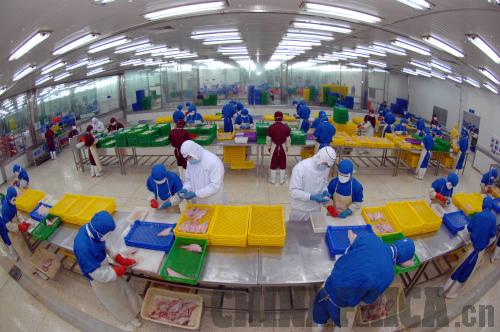|
 |
|
ECONOMIC IMBALANCE:Shifting income toward workers can lessen the gap between the poor and the rich (XINHUA) |
Removing distortions
In theory, following the comparative advantage to develop industries should lead to improvements in the distribution of income. More specifically, when an economy's development is in its early stage—with relatively abundant labor and scarce capital—enterprises will initially enter labor-intensive industries and adopt more labor-intensive technologies. This will create as many employment opportunities as possible and will transfer labor from traditional sectors to modern manufacturing and service sectors. Accompanied with the upgrading in the endowment structure, labor abundance will be replaced gradually by labor scarcity and capital scarcity will gradually become capital abundance. Accordingly, the cost of labor will increase and the cost of capital will decrease.
Because capital income is the major source of income for the rich, while labor is the major source of income for the poor, such changes in relative prices will make it possible to achieve economic growth and equity simultaneously.
In practice, however, the concentration of income in the corporate sector and rich people is a consequence of the dual-track reform process, which retains certain distortions as a way to provide continuous support to non-viable firms in the priority industries. Those distortions favor large corporations and rich people. Major remaining distortions include the concentration of financial services in the four large state-owned banks, the almost zero royalty on natural resources, and the monopoly of major service industries, including telecommunication, power and banking.
Those distortions contribute to the rising income disparity and other imbalances in the economy. This is because only big companies and rich people have access to credit services provided by the big banks, and the interest rates are artificially repressed.
Therefore, it is imperative for China to address the structural imbalances by removing the remaining distortions in the finance, natural resources and service sectors so as to complete the transition to a well-functioning market economy.
Necessary reforms include removing the financial repression and allowing the development of small and local financing institutions, including local banks, so as to increase financial services, especially the access to credit for household farms as well as small and medium-size enterprises in manufacturing and service sectors.
The pension system should be reformed to remove the old retired workers' pension burden from the state-owned mining companies and levy appropriate royalty taxes on natural resources; and we should also encourage entry and competition in the telecommunications, power and financial sectors.
Leading up to the global crisis, a burst of convergence occurred, as developing countries grew substantially faster than high-income countries. As we can see, this superior growth was widespread in developing countries across regions. This tendency is likely to continue as developing countries' growth prospects remain favorable, and high income countries' prospects remain subdued. This is not to say that the latter will not affect the former, but there is sufficient momentum in developing countries' own demand—combined with increasing south-south economic linkages—that should sustain a gap in growth rates between developing countries and high-income countries. Fortunately this convergence has also been fairly broad-based across regions of the developing world.
Contributing to the world
If China can maintain the 8-percent growth rate in the coming years, China may contribute to the multi-polar growth world in many other ways in addition to GDP growth and trade.
There will be benefits shared and opportunities created by China's growth—for both high-income countries and developing countries. For high-income countries, China's growth will expand markets for their capital goods and intermediate goods exports.
Many developing countries are still major producers of agricultural and natural resource commodities. Chinese consumption and production growth will continue to support commodities and thus help these exporters.
In addition, the Chinese Government and Chinese firms will provide funds for natural resource and infrastructure investment in emerging markets and low-income countries. This is already happening, and it is likely to continue into the future. In particular, there is a growing role of Chinese finance in the African region—the developing region with the most constrained access to finance.
The continued structural transformation of the Chinese economy will create other opportunities. As China undergoes industrial upgrading to more sophisticated product markets, it will leave the market space for other developing countries to enter the more labor-intensive industries. Chinese enterprises are expected to relocate their existing production to other lower-wage countries as they upgrade to higher value-added industries, like Japan and East Asian economies did a few decades ago. The difference is that because of its size China may become a "leading dragon" for other developing countries instead of a "lead goose" in the traditional flying geese pattern of the international diffusion of industrial development. |